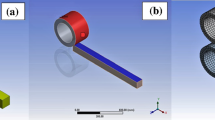Abstract
Taking the hot-rolling products made by an iron and steel company as the research object, this paper builds the inverse model reflecting the relationship between the hot-rolling steel product performance indicators, the chemical composition of steel and the rolling technological parameters by using the BP neural network. So the purpose of getting technological parameters is achieved, according to the given steel performance indicators. Combining the BP neural network, adaptive inverse control with internal model control theory, this paper builds the BP neural network inverse model with multiple input and single output based on internal model control. Therefore, it realizes the inverse mapping between the output and the input variables of the BP neural network. And the output variables can be obtained according to the input variables. Besides, this paper also gives the detailed steps to solve the inverse model. Then, the model is applied to the hot-rolling steel products quality control system. The performance indicators of the hot-rolling products are set up, and the rolling technological parameters—the rolling crimp temperature—are solved. The model realizes the controllability of rolling technological parameters. Finally, through the verification of hot-rolling products quality control positive system, the error is in line with the enterprise production requirements.












Similar content being viewed by others
References
Cochofel HJ, Wooten D, Principe J (1998) A neural network development environment for adaptive inverse control. In: IEEE international joint conference on neural networks proceedings, 1998. IEEE world congress on computational intelligence, vol 2. IEEE, pp 963–967
Ruslan FA, Samad AM, Zain ZM et al (2014) Modelling flood prediction using Radial Basis Function Neural Network (RBFNN) and inverse model: a comparative study. In: IEEE international conference on control system, computing and engineering. IEEE, pp 577–581
Kabir H, Wang Y, Yu M et al (2008) Neural network inverse modeling and applications to microwave filter design. IEEE Trans Microw Theory Tech 56(4):867–879
Karshenas M, Dunnigan MW, Williams BW (2000) Adaptive inverse control algorithm for shock testing. IEE Proc Control Theory Appl 147(3):267–276
Plett GL (2003) Adaptive inverse control of linear and nonlinear systems using dynamic neural networks. IEEE Trans Neural Netw 14(2):360
Lobato J, Cañizares P, Rodrigo MA et al (2010) Direct and inverse neural networks modelling applied to study the influence of the gas diffusion layer properties on PBI-based PEM fuel cells. Int J Hydrogen Energy 35(15):7889–7897
Hattab N, Motelica-Heino M (2014) Application of an inverse neural network model for the identification of optimal amendment to reduce copper toxicity in phytoremediated contaminated soils. J Geochem Explor 136(1):14–23
Li J, Li S, Chen X et al (2014) RBFNDOB-based neural network inverse control for non-minimum phase MIMO system with disturbances. ISA Trans 53(4):983
Sun L, Li Y, Li D (2014) Delay separated neural network inverse control in main-steam temperature system. Telkomnika Indones J Electr Eng 12(7):5244–5250
Harnold C, Lee KY (2002) Application of the free-model based neural networks in model reference adaptive inverse control. In: Proceedings of the American control conference, 2000, vol 3. IEEE, pp 1664–1668
Ding S, Wu Q (2011) Research on robustness of BP neural network based inverse model for induction motor drives. In: International conference on electronics and optoelectronics. IEEE, pp V2-127–V2-131
Várkonyi-Kóczy AR (2009) Observer-based iterative fuzzy and neural network model inversion for measurement and control applications. In: Rudas IJ, Fodor J, Kacprzyk J et al (eds) Towards intelligent engineering and information technology, SCI, vol 243. Springer, Heidelberg, pp 681–702
Wang P, Cheng B, Xing W et al (2010) The direct inverse-model control based on neural networks for inverts. In: International conference on measuring technology and mechatronics automation. IEEE, pp 855–858
Widrow B, Bilello M (1997) Adaptive inverse control. In: IEEE international symposium on intelligent control. IEEE, pp 1–6
Acknowledgements
This project was supported by Shanxi Soft Science Fund Project of China (2011041033-03). The authors would like to express thanks for the anonymous reviewers’ and the editors’ instructive suggestions which to a great degree improved the quality of this paper.
Author information
Authors and Affiliations
Corresponding authors
Ethics declarations
Conflict of interest
The authors declared that they have no conflicts of interest to this work. We declare that we do not have any commercial or associative interest that represents a conflict of interest in connection with the work submitted.
Rights and permissions
About this article
Cite this article
Xing, S., Ju, J. & Xing, J. Research on hot-rolling steel products quality control based on BP neural network inverse model. Neural Comput & Applic 31, 1577–1584 (2019). https://doi.org/10.1007/s00521-018-3547-5
Received:
Accepted:
Published:
Issue Date:
DOI: https://doi.org/10.1007/s00521-018-3547-5




